Things to do in Marrakech
With a rich and diverse cultural history and enough smells, tastes and colours to spark just about any traveller's interest, tourist attractions in Marrakech are second-to-none, and it will take visitors a while to explore all that this enchanting city has to offer. With its ochre sandstone buildings, Marrakech (known as 'The Red City') offers romance, exoticism and beauty.
Visitors should head to the Djemaa el-Fna Square where Berber merchants, travelling peddlers and entertainers such as snake charmers, musicians, fire-eaters and fortune-tellers can be found. This truly unforgettable cultural experience can feel at times like a free carnival-show. History buffs will enjoy the countless monuments to be seen and should not miss out on the Saadien Tombs, Koutoubia Mosque, El Badii Palace and the breathtaking fountains of Echrab ou Chouf and Mouassine. The Majorelle Gardens are a botanical masterpiece, having been touched by the hands of Yves Saint-Laurent and Pierre Berge, and are one of Marrakech's top tourist sights. Hop-on hop-off bus tours around Marrakech are readily available, and travellers will not be disappointed by the incredible array of attractions available for them to explore.
Marrakech is a genuinely intriguing city that invites days of sightseeing, but travellers should come prepared for some unwelcome pressure from the many touts, merchants and unofficial tour guides that throng foreigners. People in the street may misdirect tourists asking for directions into family-owned stores, and women travelling alone may encounter some unwanted attention.
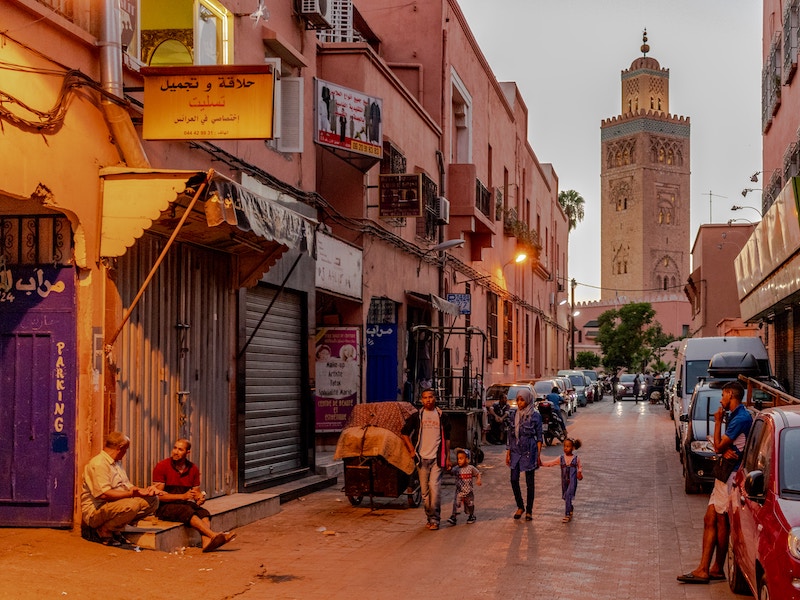
Koutoubia Mosque
Towering over the labyrinthine streets and markets of Marrakech is the city's principal landmark, the minaret of the Koutoubia Mosque, known as the 'mosque of the booksellers' beca…
Koutoubia Mosque
Towering over the labyrinthine streets and markets of Marrakech is the city's principal landmark, the minaret of the Koutoubia Mosque, known as the 'mosque of the booksellers' because of the bazaar of book traders that used to be nearby. The red stone mosque was first built in 1147, but demolished and rebuilt in 1199 because it was not correctly aligned with Mecca. The mosque has 17 aisles and 112 columns, and room for thousands to pray within. The ornately carved minbar (pulpit) is believed to have been a gift from the Almoravid Sultan Ali Ben Youssef. The minaret is 221ft (69m) high and consists of six chambers one atop the other, ascended by a ramp through which the muezzin rises to the top balcony.
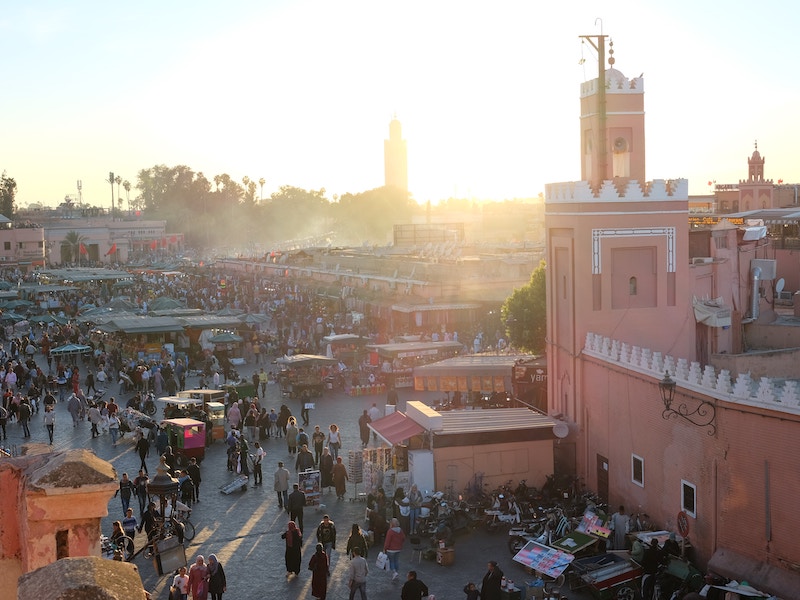
Djemaa el-Fna
What it lacks in beauty, the large town square of Marrakech, Djemaa el-Fna (Square of the Dead), makes up for with a pulsating liveliness that belies its name. Every day the square…
Djemaa el-Fna
What it lacks in beauty, the large town square of Marrakech, Djemaa el-Fna (Square of the Dead), makes up for with a pulsating liveliness that belies its name. Every day the square is a colourful circus of performing artists including snake charmers, musicians, storytellers and healers who vie with each other to be noticed by the milling crowds. Every evening food stalls take over and the competition is fierce among them for the passing trade, with everything from boiled snails and sheep's heads to thick vegetable soup, kebabs or fresh salads on offer. The square is a fascinating place to be a while relaxing at of the surrounding cafes and watching the swirling parade.
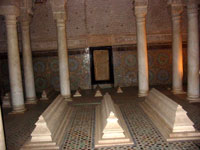
Saadian Tombs
The beautiful necropolis was built by the Saadian Sultan Ahmed el Mansour in the late 16th century as a final resting place for him and his successors. Having fallen into disrepair…
Saadian Tombs
The beautiful necropolis was built by the Saadian Sultan Ahmed el Mansour in the late 16th century as a final resting place for him and his successors. Having fallen into disrepair, the tombs were rediscovered in 1917 and carefully restored to their former splendour. There are 66 indoor tombs, lavishly decorated with colourful, intricate mosaics. The central mausoleum, the Hall of the Twelve Columns, is exceptionally ornate with a high, vaulted roof, furnished with stunning carved cedar panels and columns of grey Italian marble. The tombs are spread through three rooms and there are gardens outside the building where the graves of soldiers and servants can be seen.
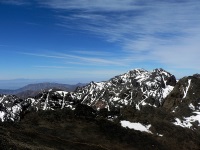
Oukaimeden
Thick snow envelops the Jebal Oukaimeden mountain peak during the winter months (usually January and February), and the desert ski resort is just a 46 mile (74km) drive from Marrak…
Oukaimeden
Thick snow envelops the Jebal Oukaimeden mountain peak during the winter months (usually January and February), and the desert ski resort is just a 46 mile (74km) drive from Marrakech. The town of Oukaimeden, which can be reached by taxi or car, is well-equipped with the basics for skiers, with restaurants, ski equipment to rent, comfortable hotels set in lush greenery and backed by blue mountains, as well as ski schools for beginners. Skiers can ascend the mountain by donkey or camel, but there are also some modern ski lifts. Five ski runs traverse down from the dizzying heights of Jebel Attar and there are nursery slopes and some intermediate runs.
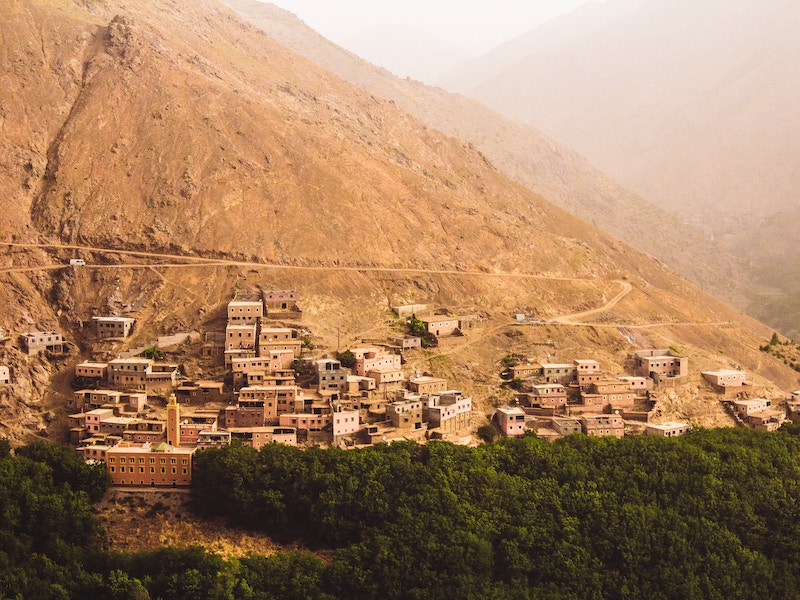
Ouirgane
The village of Ouirgane, in the foothills of the Atlas Mountains, about 90 minutes' drive from Marrakech, stands at the centre of a popular resort area, where summers are cooler an…
Ouirgane
The village of Ouirgane, in the foothills of the Atlas Mountains, about 90 minutes' drive from Marrakech, stands at the centre of a popular resort area, where summers are cooler and winters less harsh than those experienced in the city. The surrounding Berber countryside offers picturesque villages and hamlets to explore, set in pine forests full of wildlife and groves of fruit trees, alongside streams cascading down from the High Atlas Mountains and fields of wild flowers. The soil is a striking red, which emphasises the luxuriant greenery and makes the landscapes slightly otherworldly in some lights. The area is also known for its extraordinarily beautiful rose gardens.
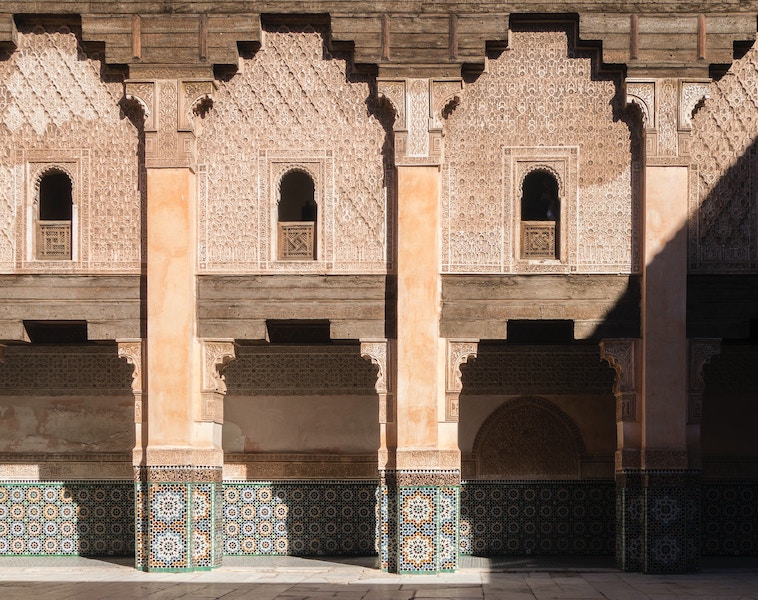
Ben Youssef Madrasa
The Ben Youssef Madrassa was once an Islamic college in Marrakech named after Sultan Ali ibn Yusuf, who expanded the city considerably. This madrassa was one of the largest theolog…
Ben Youssef Madrasa
The Ben Youssef Madrassa was once an Islamic college in Marrakech named after Sultan Ali ibn Yusuf, who expanded the city considerably. This madrassa was one of the largest theological colleges in North Africa and may have housed as many as 900 students. After being closed down in 1960, it was refurbished and reopened in 1982, an interesting attraction for the value of its educational influence, but mostly thrilling for tourists because of the stunning architecture and mosaics. The courtyards and patios are richly carved in marble, cedar and stucco, with intricate geometric patterns and Islamic inscriptions. The Ben Youssef Madrassa is often ranked as one of the best attractions of Marrakech.
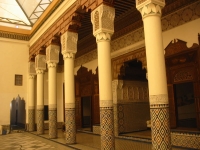
The Museum of Marrakech
The Museum of Marrakech is located in the Dar Menebhi Palace, built at the end of the 19th century by legendary Mehdi Menebhi, in the old centre of Marrakech. The palace was restor…
The Museum of Marrakech
The Museum of Marrakech is located in the Dar Menebhi Palace, built at the end of the 19th century by legendary Mehdi Menebhi, in the old centre of Marrakech. The palace was restored by the Omar Benjelloun Foundation and converted into a museum in 1997. The house itself is representative of classical Andalusian architecture, with fountains in the central courtyard, numerous carvings and beautiful tiles. The museum holds exhibits of both modern and traditional Moroccan art, as well as historical books, coins, pottery and other Berber artefacts. The convenient location and interesting building make this a worthwhile stop, even for the museum-phobic, and it is one of the most popular attractions in the city.
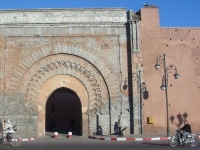
Bab Agnaou
Bab Agnaou is one of the 19 gates of Marrakech and was built in the 12th century, in the time of the Almohad Dynasty, and stands the innermost and most ornate of the city's gates a…
Bab Agnaou
Bab Agnaou is one of the 19 gates of Marrakech and was built in the 12th century, in the time of the Almohad Dynasty, and stands the innermost and most ornate of the city's gates and was one of the first stone monuments built in Marrakech. The colour of the stone seems to change drastically depending on the light, weather and time of day, and the bas-relief is sophisticated and still impressive to this day. Experts believe that the function of the gate may have been nationally symbolic, as suggested by the corner-pieces that are decorated with floral designs, framed by three panels with inscriptions from the Quran.
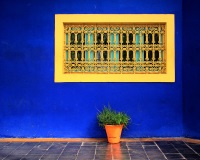
Majorelle Garden
The Majorelle Garden is a botanical garden designed by the French artist, Jacques Majorelle, in 1924. Previous owners have included Pierre Berge and Yves Saint-Laurent (whose ashes…
Majorelle Garden
The Majorelle Garden is a botanical garden designed by the French artist, Jacques Majorelle, in 1924. Previous owners have included Pierre Berge and Yves Saint-Laurent (whose ashes were scattered there when he died in 2008). The garden is also home to the Islamic Art Museum of Marrakech, which houses an exhibit of North African textiles from Saint-Laurent's personal collection, and paintings by Majorelle. The garden is home to more than 15 bird species endemic to North Africa, and full of ponds and water features. The garden took 40 years to create. It is one of the most popular tourist sites in Morocco and a must for all visitors.
Website www.jardinmajorelle.com
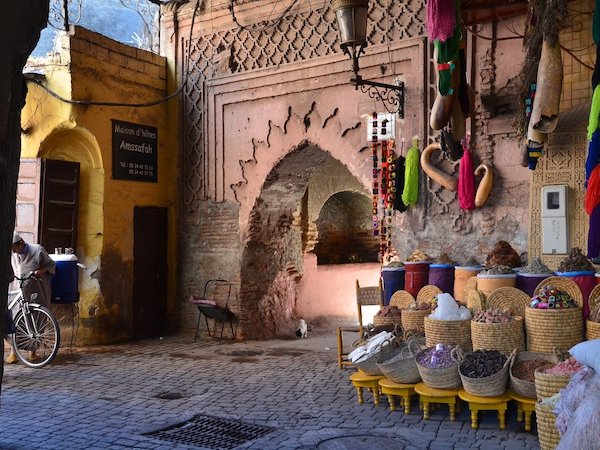
The souks of Marrakech
Marrakech is home to a labyrinth of bustling souks (workshops and markets) that offer the city's most fascinating wares. The northern end of the souks, best accessed from the Ben Y…
The souks of Marrakech
Marrakech is home to a labyrinth of bustling souks (workshops and markets) that offer the city's most fascinating wares. The northern end of the souks, best accessed from the Ben Youssef Mosque, remains refreshingly unspoilt with blacksmiths making wrought-iron goods and alleys filled with the distinct odour of leather workshops. The stalls emerge further south and are met by the Rahba Kedima, a market famous for its bizarre offerings of animals and eccentric potions for spells. The market is colourful and crowded with plenty of fodder for keen photographers. The souks are a wonderful experience and many foreigners visit repeatedly during their stay.
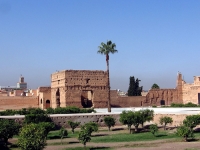
El Badi Palace
The El Badi Palace ('the incomparable palace') consists of the remnants of a glorious palace built by the Saadian King, Ahmad al-Mansur, in 1578. The original building is thought t…
El Badi Palace
The El Badi Palace ('the incomparable palace') consists of the remnants of a glorious palace built by the Saadian King, Ahmad al-Mansur, in 1578. The original building is thought to have had about 360 rooms, a courtyard and a pool, and was decorated with Italian marble and large amounts of Sudanese gold. It also had a small, underground jail where the king kept his prisoners. The design of the palace was influenced by Granada's Alhambra, but the original palace was torn apart by Sultan Mawlay Ismail. Today, the once luxurious palace is a ruin consisting of some intact rooms and numerous walls, terraces, gardens and foundations. The underground jail can still be explored and a number of beautiful mosaics survive.
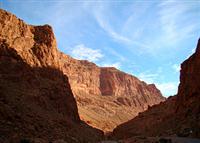
Todra Gorge
The Todra Gorge, a canyon on the eastern side of the High Atlas Mountains, is undoubtedly one of the most spectacular natural attractions that Morocco has to offer. Nature lovers w…
Todra Gorge
The Todra Gorge, a canyon on the eastern side of the High Atlas Mountains, is undoubtedly one of the most spectacular natural attractions that Morocco has to offer. Nature lovers who feel starved in the choked streets of Morocco's cities can simply take the trip to the Todra Gorge (most easily accessed from the town of Tinerhir) where they will be rewarded with the experience of a lifetime. To put the grandeur of the gorge into perspective, travellers should consider that over its final 1,950 feet (600m), the canyon narrows to a rocky passage only 33 feet (10m) wide, while the sheer walls rise up 984 feet (300m) on either side.
Ait Benhaddou
Ait Benhaddou is an ancient fortified city (ksar) situated along the former caravan route between the Sahara and Marrakech. It is certainly one of the most breathtaking tourist att…
Ait Benhaddou
Ait Benhaddou is an ancient fortified city (ksar) situated along the former caravan route between the Sahara and Marrakech. It is certainly one of the most breathtaking tourist attractions in Morocco. A UNESCO World Heritage Site, Ait Benhaddou is not only a place of great historical significance that stands as a record of Maghreb architectural practices, but is so immediately evocative of the most romantic visions of ancient Arabia that visitors may mistake it for a fanciful mirage. The buildings are constructed against a mountain and surrounded by steep defensive walls, and are all built from moulded earth and clay brick.
Essaouira
Essaouira is a picturesque coastal city that's an easy three-hour drive from Marrakech, and with direct flights from many European cities it has become a popular short-break destin…
Essaouira
Essaouira is a picturesque coastal city that's an easy three-hour drive from Marrakech, and with direct flights from many European cities it has become a popular short-break destination. The town is encircled by a fortified wall and faces the sea, featuring a beautiful stretch of beach, pretty whitewashed houses, a bustling souk, restaurants and art galleries. What makes Essaouira popular is the laid-back holiday atmosphere, and the melting pot of cultures, with local Moroccans in flowing djellabas, European holidaymakers bargaining for berber rugs and jewellery, hippy backpackers and adventure-seekers attracted to one of the world's best kitesurfing destinations. While the reliable coastal wind makes it a perfect place for windsurfing and kite surfing, the wind can make sunbathing more difficult, though there are plenty of excellent hotels to relax at.
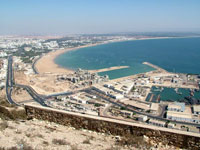
Agadir
The holiday destination of Agadir, south of Marrakech, is contemporary and fresh, and is fast developing into Morocco's major resort town. Agadier was rebuilt as an important seapo…
Agadir
The holiday destination of Agadir, south of Marrakech, is contemporary and fresh, and is fast developing into Morocco's major resort town. Agadier was rebuilt as an important seaport and centre for caravans traversing the Sahara after an earthquake wiped out most of its historic heritage in 1960. The rebuilt city has been modelled as a tourist destination and fishing port, favoured by package tours, particularly as a starting point for excursions into the Western Sahara to the south. Agadir has a lovely promenade along the coast and a vibrant restaurant and cafe culture tailored towards tourists. The nightlife is also fast developing and the shopping scene shouldn't disappoint.



